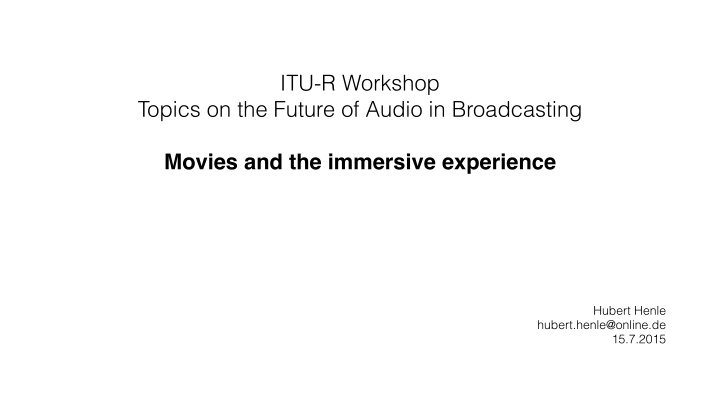



ITU-R Workshop Topics on the Future of Audio in Broadcasting Movies and the immersive experience Hubert Henle hubert.henle@online.de 15.7.2015
Overview o Adaption of theatrical immersive sound formats o Options for user interactivity ITU-R Workshop “Topics on the Future of Audio in Broadcasting” Hubert Henle 15.7.2015
Overview Adaption of theatrical immersive sound formats Options for user interactivity ITU-R Workshop “Topics on the Future of Audio in Broadcasting” Hubert Henle 15.7.2015
Adaption of theatrical immersive sound formats Audio formats currently in use for feature film soundtracks • Channel based • 5.1 (L-C-R-Ls-Rs-SW) • 7.1 (L-C-R-Ls-Bsl-Bsr-Rs-SW) Non-Immersive Immersive • 11.1 Auro 3D (5.1 + 5 Height + 1 Overhead) • Formats supporting audio objects • Dolby Atmos (9.1 + 118 objects, 64 speaker positions) ITU-R Workshop “Topics on the Future of Audio in Broadcasting” Hubert Henle 15.7.2015
Adaption of theatrical immersive sound formats
Adaption of theatrical immersive sound formats
Adaption of theatrical immersive sound formats Audio formats currently in use for feature film soundtracks • Channel based • 5.1 (L-C-R-Ls-Rs-SW) • 7.1 (L-C-R-Ls-Bsl-Bsr-Rs-SW) Non-Immersive Immersive • 11.1 Auro 3D (5.1 + 5 Height + 1 Overhead) • Formats supporting audio objects • Dolby Atmos (9.1 + 118 objects, 64 speaker positions) ITU-R Workshop “Topics on the Future of Audio in Broadcasting” Hubert Henle 15.7.2015
Adaption of theatrical immersive sound formats Challenge: Number of Objects and speakers • Dolby Atmos supports 9.1 „bed“ and 118 simultaneous objects rendered into 64 speaker locations • However: Not all objects will actually be dynamic i.e. moving! • It is unrealistic to replicate this in a consumer format • Bandwidth of transmission and playback renderer • Speaker resolution ITU-R Workshop “Topics on the Future of Audio in Broadcasting” Hubert Henle 15.7.2015
Adaption of theatrical immersive sound formats
Adaption of theatrical immersive sound formats Manage Objects • Pre-Rendering into channel format • Transform into Higher-Order Ambisonic format • Preserve (selected) objects ITU-R Workshop “Topics on the Future of Audio in Broadcasting” Hubert Henle 15.7.2015
Adaption of theatrical immersive sound formats Manage Dynamic Objects: Pre-Rendering • 7.1 + 4 channel format • Rendering tools for ProTools available • Full control on production side • No metadata • Possibly limited flexibility with speaker placement in the home ITU-R Workshop “Topics on the Future of Audio in Broadcasting” Hubert Henle 15.7.2015
Adaption of theatrical immersive sound formats Manage Dynamic Objects: Higher-Order Ambisonic • More flexibility with speaker placement • Preserves location information ITU-R Workshop “Topics on the Future of Audio in Broadcasting” Hubert Henle 15.7.2015
Adaption of theatrical immersive sound formats Manage Dynamic Objects: Preserve selected objects • Conversion of source metadata into MPEG-H format • Remaining objects processed as described above • Requires artistic decisions by the content creator ITU-R Workshop “Topics on the Future of Audio in Broadcasting” Hubert Henle 15.7.2015
Overview Adaption of theatrical immersive sound formats Options for user interactivity ITU-R Workshop “Topics on the Future of Audio in Broadcasting” Hubert Henle 15.7.2015
Options for user interactivity Interactivity for movie soundtracks? • Rebalance dialogue against music and effects • Choice between different language versions Dialogue must be delivered separately!
Options for user interactivity 5.1 Workflow in feature film mixing Sound-Elements Pre-Dubs Final Mix Dialog . . . Dialog 5.1 Dialog Dialog Dialog Music . ProTools ProTools . Music and/or and/or 5.1 Music Music . Mixing Console Mixing Console Music 5.1 M&E Effects Effects . 5.1 Effects Effects . . Effects
Options for user interactivity Interactivity for movie soundtracks • 5.1 dialogue and M&E available as standard deliverable from (almost) all feature film mixes • Dialogue can be delivered as an audio object in MPEG-H • Bandwidth overhead reasonable
Options for user interactivity Rebalance dialogue against M&E • Personal preferences • Adapt to listening environment • Simple GUI to allow rebalancing within reasonable limits (set by metadata)
Options for user interactivity Choice between different language versions • Multiple language versions in single transport stream • Alternative delivery methods for additional languages • Broadcaster’s webpage
Options for user interactivity Other benefits • DRC • Dialogue and M&E can be processed independently • Less prone to unwanted side effects
ITU-R Workshop Topics on the Future of Audio in Broadcasting Movies and the immersive experience Thank you! Hubert Henle hubert.henle@online.de 15.7.2015
Recommend
More recommend